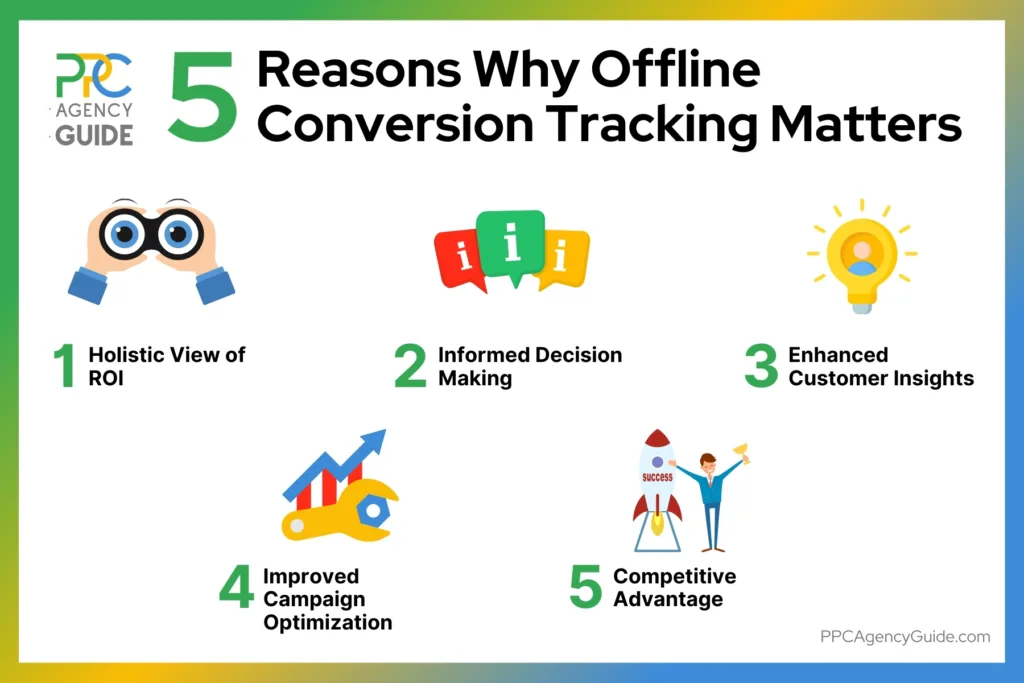Three out of four people who search on their smartphones for something nearby visit a business within a day, Google reports. That means if you’re running search ads and not tracking offline conversions, you’re literally overlooking the majority of your conversions. But this is only part of the picture. Offline conversions occur with lots of different ad types, and customers convert in many ways. On this page, we’ll explore how overlooking these conversions shortchanges your business, how to track offline conversions, what to do with the data you collect, and how to address the most common challenges with analysis so you can start making the most of your offline conversions right away.
Why Offline Conversion Tracking Matters
While a substantial amount of shopping and business transactions occur online, a significant portion still happens offline in physical locations, such as retail stores, offices, or over the phone. For many businesses, especially those that offer high-value products or services requiring consideration, the customer journey might start online, but the deal is sealed offline. Understanding this journey is critical for several reasons.
Holistic View of ROI

Tracking offline conversions lets you see your total return on investment (ROI) from PPC campaigns. Without this data, it’s easy to undervalue online advertising efforts since you only see a part of the picture—the online conversions. By attributing offline sales back to their online origins, you can accurately assess the effectiveness of their PPC campaigns.
Informed Decision Making
With a comprehensive dataset that includes both online and offline conversions, you can make more informed decisions about where to allocate your marketing budget for maximum impact. This insight lets you adjust your PPC strategies to target audiences more effectively, optimize bids, and refine ad copy.
Enhanced Customer Insights
Understanding which online ads lead to offline sales provides deeper insights into customer behavior and preferences. This knowledge allows you to tailor your marketing messages, product development, and customer service to better meet your target audience’s needs.
Improved Campaign Optimization
By tracking offline conversions, you can identify which keywords, ad groups, and campaigns are driving the most valuable actions, allowing you to optimize your PPC campaigns for both online and offline success.
Competitive Advantage
Many businesses still struggle to link their online marketing efforts to offline results. Mastering this can give you a significant competitive advantage, allowing you to leverage insights others might miss and capture more market share.
Methods for Tracking Offline Conversions
Tracking offline conversions from PPC ads involves bridging the gap between online marketing activities and offline customer actions. You can use several methods to link these two worlds, ranging from simple tracking techniques to more advanced, technology-driven solutions.
Unique Phone Numbers
By using unique phone numbers for each PPC campaign or even specific ads, businesses can easily track which campaigns are driving calls to their business. Services like call tracking software can dynamically replace the phone number on a website based on how a visitor arrives, making it easy to attribute phone inquiries to the correct PPC campaign.
Promotional Codes and Coupons
Offering unique promotional codes or coupons through PPC ads is another method to track offline conversions. When a customer uses the code in-store or over the phone, you can link that sale back to the specific ad campaign. This method is simple and effective, especially for retail and e-commerce businesses.
Google Ads Conversion Tracking with Offline Data Import
Google Ads offers a feature that allows businesses to import offline conversion data directly into their account. This process involves assigning a unique identifier (like a lead ID or transaction number) to a user’s click on an ad. When the offline conversion occurs, this identifier is used to upload the conversion data back into Google Ads, attributing it to the correct user and campaign. This method is particularly useful for high-value transactions that occur over time, such as car sales or B2B contracts.
Customer Surveys
While more manual, asking customers how they heard about your business can provide valuable insights. This method can be implemented during the checkout process, through follow-up emails, or during post-purchase surveys. Although it’s dependent on customer recall and participation, it can still yield valuable data for attributing sales to PPC campaigns.
Beacon Technology
For a more advanced approach, some retailers use beacon technology in-store to track when customers who have viewed PPC ads visit their physical locations. This technology requires a mobile app and Bluetooth enabled on the customer’s device, but it offers precise data on how online advertising influences offline behavior.
Integrating Offline Data with Online Campaigns
Integrating offline data with online campaigns is a sophisticated strategy that can significantly enhance the effectiveness of a business’s digital marketing efforts. This integration allows for a more holistic view of customer behavior, preferences, and the customer journey as a whole.
Integrating CRM for a Holistic View
Integrating PPC data with a customer relationship management (CRM) system can be incredibly powerful for businesses that rely on lead generation and have a longer sales cycle. By tagging leads generated from PPC campaigns and tracking their progress through the sales funnel, you can attribute offline sales back to their initial online interaction. This requires a bit of setup but provides a comprehensive view of a campaign’s effectiveness.
Understanding Customer Behavior
Offline data provides insights into the parts of the customer journey that occur outside the digital realm. For example, purchase patterns, customer service interactions, and in-store behavior can all inform online campaign strategies. Understanding why customers prefer to complete their transactions offline or what drives them into a physical store can help you craft more persuasive online messaging and targeting.
Enhancing Audience Targeting
Offline data can enrich customer profiles, enabling more precise audience segmentation. You can create detailed customer segments by integrating information such as in-store purchase history, demographic data from loyalty programs, and service preferences. These segments can then be mirrored in online advertising platforms (like Google Ads or Facebook) through custom audience targeting or lookalike audience creation, allowing you to reach individuals who resemble their best offline customers.
Personalizing Online Experiences
The insights gained from offline interactions can be used to personalize online marketing messages, landing pages, and offers. For instance, if offline data reveals that certain customer segments respond well to specific product categories or offers, these insights can be used to customize the online experience for those segments, increasing the relevance and effectiveness of online campaigns.
Refining Product and Offer Strategy
Offline sales data can highlight the most popular or profitable products or services. This information can guide online advertising strategies, ensuring that the most compelling offers are highlighted in PPC campaigns. Additionally, understanding the offline customer journey can help you create more effective online-to-offline (O2O) marketing campaigns, encouraging online browsers to become offline buyers.
Improving Attribution Modeling
Integrating offline conversion data with online campaigns helps you develop more accurate attribution models. By understanding the entire conversion path, including offline interactions, businesses can better assess the impact of various marketing touchpoints. This improved attribution enables more informed budget allocation and campaign optimization decisions, ensuring your marketing spend is directed towards the most effective channels and tactics.
Using Offline Data to Refine Online Strategies

To effectively use offline data for refining online strategies, businesses should:
- Implement a Data Integration Platform: Utilize Customer Data Platforms (CDPs) or other integration tools to merge offline and online data, ensuring a unified view of the customer journey.
- Adopt a Test and Learn Approach: Use insights from offline data to test hypotheses in online campaigns. For example, if offline data suggests a particular customer segment is growing, test targeted online campaigns to engage this segment.
- Focus on Personalization: Leverage offline insights to personalize online interactions. This could range from targeted email marketing based on in-store purchase history to personalized ad creatives that reflect known customer preferences.
- Continuously Optimize: Use the ongoing influx of offline data to continually refine and optimize online campaigns. This means regularly updating audience segments, personalization strategies, and campaign creatives based on the latest offline insights.
Analyzing and Interpreting Offline Conversion Data
Analyzing and interpreting offline conversion data is critical in understanding the full impact of your PPC ads and refining your online strategies based on comprehensive insights.
Analyzing Offline Conversion Data
Once you’ve implemented methods to track offline conversions from your PPC campaigns, the next step is to analyze this data to gauge campaign effectiveness and ROI. Integrating offline conversion data with your online campaign data provides a holistic view of customer behavior and campaign performance.
- Conversion Path Analysis: Understand the steps a customer takes, from clicking on an ad to making an offline purchase. This involves looking at touchpoints such as phone calls, in-store visits, or consultations booked via your website.
- ROI Calculation: Calculate the return on investment by comparing the cost of your PPC campaigns against the revenue generated from both online and offline conversions. This can highlight the true value of your advertising efforts.
- Customer Lifetime Value (CLV): Assessing the lifetime value of customers acquired through PPC campaigns can inform your bidding strategy and budget allocation. Customers with a higher CLV might justify a higher cost per acquisition (CPA).
Key Metrics for Measuring Offline Success
Several metrics are pivotal in measuring the success of your campaigns in driving offline conversions.
- Cost Per Offline Conversion: Calculate the cost associated with acquiring an offline conversion to evaluate the efficiency of your campaigns.
- Offline Conversion Rate: The percentage of leads generated from PPC ads that result in offline conversions.
- Average Order Value (AOV): The average amount spent by customers who convert offline, which can help you assess the profitability of campaigns.
- Customer Retention Rate: For businesses with repeat customers, tracking how PPC-driven customers return over time can offer insights into customer loyalty and campaign effectiveness.
Challenges and Solutions in Data Analysis
Gathering and analyzing data may seem complicated, but some of the most common challenges involve straightforward solutions. We’ll review a few of these below.
Challenge 1: Data Integration
Integrating offline conversion data with online campaign data can be technically challenging, requiring a consistent and error-free method of tracking and attribution.
Solution: Use CRM and analytics platforms that have integration capabilities with advertising platforms like Google Ads. Consistently use unique identifiers to track conversions across platforms.
Challenge 2: Data Accuracy and Completeness
Ensuring the accuracy of offline conversion data and its attribution to the correct PPC campaign can be difficult, especially when relying on manual methods like customer surveys or promotional codes.
Solution: Automate data collection as much as possible and use technology solutions like call tracking and CRM integration to minimize human error.
Challenge 3: Multi-Touch Attribution
Many customers interact with multiple ads or touchpoints before converting, making it hard to attribute conversions to a single ad or campaign.
Solution: Implement a multi-touch attribution model that allocates credit to various touchpoints along the customer journey. This approach acknowledges the complexity of the conversion path and provides a more nuanced understanding of campaign performance.
Challenge 4: Privacy Regulations
Complying with privacy regulations such as GDPR and CCPA while tracking customers from online interactions to offline conversions can be complex.
Solution: Ensure all tracking methods comply with privacy laws by obtaining consent where required and anonymizing personal data when possible.
Get Help Maximizing and Tracking Offline Conversions
Tracking offline conversions is essential for measuring and maximizing your PPC ROI. Still, it requires a mix of skills, including technical prowess, analytics knowledge, the right tools, a cohesive strategy, and a deep understanding of PPC. Because of this, it’s usually something businesses work with a PPC expert to accomplish. We’re happy to match you with an experienced PPC agency that understands the nuances of offline conversion tracking and can develop a tailored strategy for your business. To get help maximizing and tracking your offline conversions, request a complimentary consultation.


















